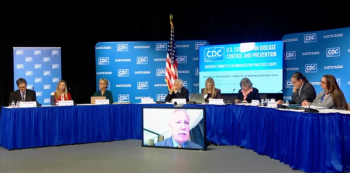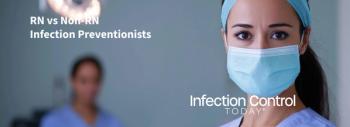
Infection Control Today - 08/2002: Success Story
New High-Level Disinfectant Reduces Equipment-Repair Costs
By Celine Vollmer, RN
Providinghigh-quality patient care while controlling costs is an ongoing challenge forhealthcare facilities and requires hospital administrators to closely monitorexpenses while focusing on quality of care, employee safety and productivity.This is especially true for large hospitals like Baptist Hospital East, one ofthe largest non-profit, acute-care healthcare facilities in Kentucky. Our407-bed facility treats more than 177,000 inpatients and outpatients annually.
The endoscopy department at Baptist East performs approximately 1,000minimally invasive procedures each month and must ensure the ready availabilityof flexible endoscopes. In this high-volume department, efficient and effectivecleaning and disinfecting of endoscopes is a priority in order to providehigh-quality patient care, ensure equipment integrity, and maintain thehospital's busy surgical schedule.
During the last 10 years, the department has used a variety of methods toprocess its endoscope inventory. Each method had its own set of problems,including a serious increase in equipment damage. Then, in early 2000, thedepartment adopted OPA (0.55 percent ortho-phthalaldehyde solution), a newhigh-level disinfectant for fast, safe and effective instrument processing.After two years using OPA, several benefits were identified, including increasedconvenience, improved patient care and reduced repair costs.
Processing Methods Evaluated
In 1995, the department used a liquid high-level disinfectant containingglutaraldehyde to reprocess its large, 15-endoscope inventory. Theglutaraldehyde disinfectant had a high level of materials compatibility and wasinexpensive to purchase on a per-gallon basis. However, in practice theglutaraldehyde disinfectant was costly to use. Due to the high volume ofendoscopes processed, the glutaraldehyde disinfectant rarely maintained itsminimum effective concentration (MEC) for a full 14 days, requiring thedepartment to purchase and use more of the solution, thus increasing costs.
In addition, the glutaraldehyde disinfectant had several safety and handlingrequirements. The risk of exposure associated with the glutaraldehydedisinfectant motivated the department to consider alternative instrumentprocessing technologies. After evaluating its needs and researching severaldifferent processing methods, the department converted to a peracetic acidsterilization system.
Peracetic acid systems sterilize surgical and diagnostic instruments anddevices, including endoscopes, through an automatic process that the departmentfelt would alleviate the safety and handling concerns associated withglutaraldehyde. And, while the new system addressed those specific concerns, itcreated separate but equally serious problems. The most serious problemexperienced during the three years the peracetic acid system was in use was asignificant increase in equipment damage and repair costs.
An investigation conducted by the department into the cause of the damageconfirmed that the source was the peracetic acid system. Although the peraceticacid contained erosion and degradation inhibitors, resins that supported theendoscope lenses were compromised, and moisture infiltrated the innercomponents, thus damaging the equipment. The department spent more than $160,000on endoscope repairs in 1999, an increase of $20,000 compared withglutaraldehyde. In addition to the increase in repair bills, the large number ofendoscopes sent for repair affected the department's ability to keep up with ademanding endoscopic surgery schedule. In some instances, damaged endoscopeswere discovered immediately before a procedure, causing delays until another,undamaged endoscope was available.
Once more, the department was forced to evaluate its instrument processingpractices. With limited choices for flexible endoscope reprocessing, and despitehandling and cost concerns, the department decided to return to glutaraldehyde-- the only alternative available at the time.
A New High-Level Disinfectant
In November 1999, CIDEX OPA Solution received U.S. Food and DrugAdministration (FDA) approval for marketing. OPA is glutaraldehyde-free, almostwithout odor and compatible with a wide range of endoscopes and other medicaldevices. It has a 12-minute processing time at room temperature (20 degrees C),and allows high-volume patient care areas, to avoid surgical delays. The rapidthroughput of endoscopes and medical instruments decreases capital costs byreducing the number of additional endoscopes a facility must purchase.
Implementing OPA
The introduction of OPA to the U.S. marketplace provided Baptist East with asolution to the problems associated with its instrument processing methods. Inearly 2000, with the support of hospital physicians and administrators, theendoscopy department at Baptist East began the acquisition process for OPA anddeveloped a standard protocol for instrument processing with this new high-leveldisinfectant. Although instruments can be manually processed using OPA, thedepartment purchased automatic endoscope reprocessors for use with the newsolution to enhance efficiency.
In March 2000, the department's conversion to OPA was complete. Thetransition was problem free, and the new high-level disinfectant proved to beextremely user friendly. The absence of noxious fumes and low level of toxicity,compared with glutaraldehyde and peracetic acid, dramatically improved staffcomfort, satisfaction and safety, stemming in part from the low concentration(0.55 percent) of active ingredient.
Cost Savings
Since switching to OPA, Baptist East's endoscopy department has experienced asignificant reduction in costs for equipment repair and replacement. After oneyear using OPA, the department recorded a 77 percent decrease in repair costs --saving the hospital more than $120,000. In addition, because damage to expensiveflexible endoscopes was rare and utilization increased due to OPA's 12-minuteprocessing time, surgical procedures were seldom delayed or postponed -- furtherreducing costs and benefiting physicians and patients. Finally, additional costsavings were achieved due to the efficacy of OPA. Unlike glutaraldehyde, OPAmaintains its MEC with heavy use for a full 14 days.
Celine Vollmer, RN, is nurse manager of the endoscopy department atBaptist Hospital East Hospital in Louisville, Ky.
Newsletter
Stay prepared and protected with Infection Control Today's newsletter, delivering essential updates, best practices, and expert insights for infection preventionists.






